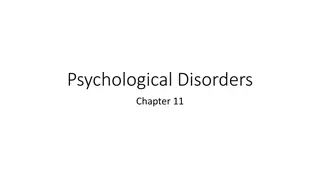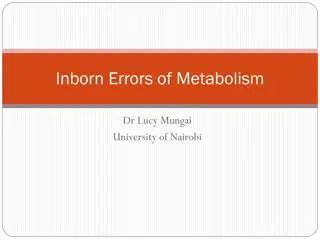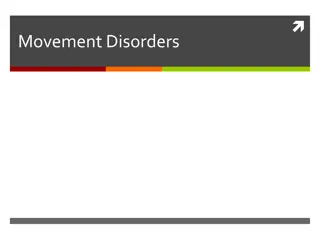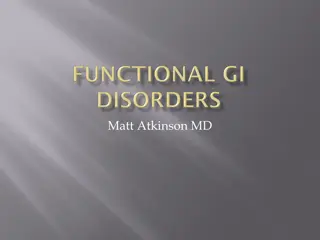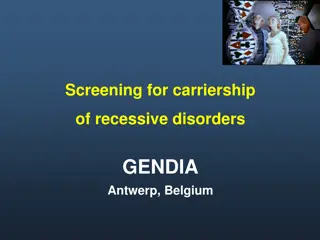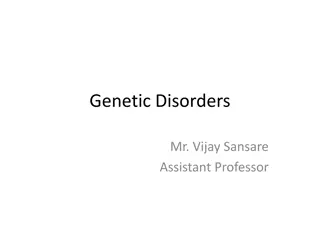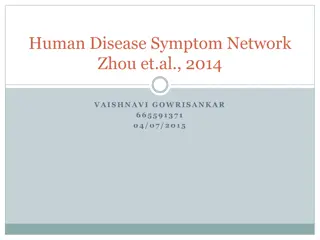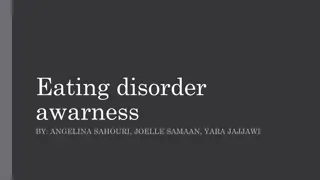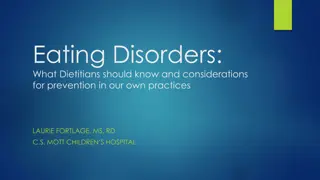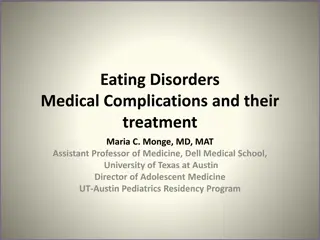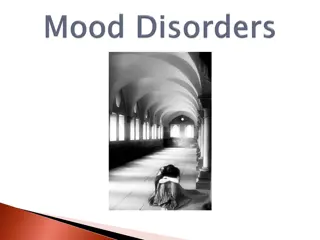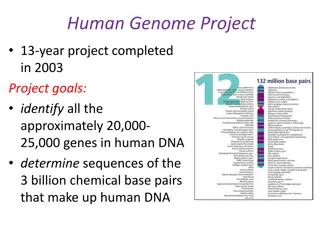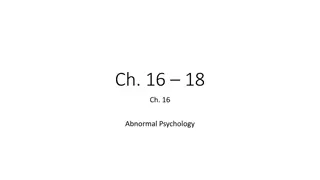Creutzfeldt-Jakob Disease and Prion Disorders Overview
In this comprehensive overview, various aspects of Creutzfeldt-Jakob Disease (CJD) and other prion diseases are discussed, including terminology, history, epidemiology, and characteristics. The content covers the prion theory, types of CJD, transmission modes, and important abbreviations related to these neurodegenerative diseases. Visual aids illustrate concepts such as PrPc and PrPsc conversion. Additionally, the role of regional and local health departments in managing CJD cases is highlighted, alongside steps for investigation and available resources.
Download Presentation

Please find below an Image/Link to download the presentation.
The content on the website is provided AS IS for your information and personal use only. It may not be sold, licensed, or shared on other websites without obtaining consent from the author.If you encounter any issues during the download, it is possible that the publisher has removed the file from their server.
You are allowed to download the files provided on this website for personal or commercial use, subject to the condition that they are used lawfully. All files are the property of their respective owners.
The content on the website is provided AS IS for your information and personal use only. It may not be sold, licensed, or shared on other websites without obtaining consent from the author.
E N D
Presentation Transcript
Creutzfeldt-Jakob Disease and other Prion Diseases Michael Fischer, MD, MPH & TM Epidemiologist Creutzfeldt-Jakob Disease
Outline: Discuss terminology and abbreviations The prion, prion theory, and transmissible spongiform encephalopathies History of transmissible spongiform encephalopathies Bovine spongiform encephalopathy and variant Creutzfeldt-Jakob Disease (United States focus) Discuss the Journal of Emerging Infectious Diseases: Iatrogenic Creutzfeldt-Jakob Disease, Final Assessment The State of Texas and CJD, case counts, local and regional health departments, vital statistics, and NPDPSC Areas where regional and local health departments can play an important role Steps to keep in mind for investigation of iatrogenic CJD due to surgical instrument contamination Resources on CJD that are nice to keep on hand
Abbreviations TSE Transmissible Spongiform Encephalopathy (prion disease) CJD Creutzfeldt-Jakob Disease sCJD sporadic CJD (1/million per year) (85%ofCJD) fCJD familial CJD iCJD iatrogenic CJD sFI sporadic Fatal Insomnia FFI Familial Fatal Insomnia vCJD variant Creutzfeldt-Jakob Disease BSE Bovine Spongiform Encephalopathy ( mad cow disease) CWD Chronic Wasting Disease (10-15%) (<1%)
Prion and Prion Theory Prion: A proteinaceous infectious particle resistant to procedures that modify nucleic acid Prion theory: Prions propagate by transmitting a misfolded protein state. It induces existing, properly folded proteins to convert into the disease-associated, prion form; the prion acts as a template to guide the miss-folding of more proteins into prion form. The newly formed prions can then go on to convert more proteins themselves; this triggers a chain reaction that produces large amounts of the prion form.
Characteristics Transmissible Spongiform Encephalopathies (TSEs): Neurodegenerative diseases Rapidly progressive, always fatal Long incubation periods Brain, spinal cord, and adjacent tissues are considered infectious Absence of Immune response Neuropathology amyloid plaques, no inflammatory reactions, and reactive gliosis; neuronal loss & spongiform changes Affect humans and animals
Some of the common diseases that will be in a differential diagnosis and need to be ruled out before a diagnosis of CJD is made Alzheimer and vascular dementia Herpes encephalitis Multiple sclerosis Hashimoto encephalitis Alzheimer's disease (AD) Dementia with Lewy bodies (DLB) Vascular dementia (VD) Chronic inflammatory disorders Hashimoto s thyroiditis leading to Hashimoto encephalitis, Infectious or granulomatous processes (eg, neurosyphilis, CNS fungal disease, sarcoid, HIV-1- related diseases, Lyme disease), tumors, and vasculitis Toxins (especially inorganic mercury) A primary central nervous system vasculitis with little or no laboratory evidence of systemic inflammation Hashimoto thyroiditis Paraneoplastic syndromes (eg, cerebellar degeneration or limbic encephalitis) "Mixed" degenerative processes (eg, Lewy body dementia, frontotemporal dementia,Parkinson disease with dementia Amyotrophic lateral sclerosis with dementia
A Quick History Lesson: 1730s: A written record on Scrapie in English sheep, the disease is seen all throughout Europe. 1920s: CJD first described 1950 s:Symptoms similar to Scrapie were found in a tribe of natives that practiced ritualistic cannibalism of their dead in Papua New Guinea . The tribe named the disease Kuru 1960s:Scientists experimentally transmit Kuru and CJD to chimpanzees, leading the conclusion that is transmissible! 1970 s: Iatrogenic CJD cases identified corneal transplants, silver electrodes 1982:Stanley Prusiner coins the term prion (Proteinaceous infectious Particle) Highly purified PrP-res is shown to be infectious. 1985:Iatrogenic CJD associated with human growth hormones 1987: Dura mater grafts implicated as cause of iatrogenic CJD 1997:Stanley Prusiner won the Nobel Prize in Physiology and Medicine 2000: Mad Cow Disease outbreak- 180,000 cattle has been estimated to be infected. 2005:vCJD is linked to exposure to BSE from British beef causing 155 deaths in the U.K.
Bovine Spongiform Encephalopathy (BSE) in the United States: There have been four cases of BSE in cattle identified in the United States. 1. The first case of BSE was identified in Washington State (2002) and the cow was found to have been imported from Canada. 2. In 2004 BSE was identified in a Texas-born cow representing the first native case in the United States. 3. A second native case was reported in Alabama during 2006. 4. A third native case was reported in California this past year (2012); o A dairy cow, not intended for slaughter, o Neuropathology analysis was performed o Case was confirmed as a sporadic case of BSE
vCJD World-Wide From October 1996 to March 2011 (WHO website) 175 cases of vCJD have been reported in the United Kingdom (3 are secondary cases of vCJD related to blood transfusion) 25 in France 5 in Spain 4 in Ireland 3 in the Netherlands 3 in the United States of America (USA) 2 each in Canada, Italy and Portugal 1 each in Japan, Saudi Arabia and Taiwan. The number of cases of vCJD in the United Kingdom peaked in 2000 with 28 deaths. It has since declined to about 2 diagnosed cases and 2 deaths per year in 2008.
vCJD In the United States: There have been three cases The first case-patient was born in the United Kingdom in the late 1970s and lived there until relocating to Florida in 1995. Onset of symptoms began in 2001 and the patient died in 2004. The second case patient was born and raised in England before moving to Texas in 2001. Symptoms began in 2005 and were confirmed neuropathologically (by autopsy) in 2006 by experts in the United Kingdom. Both the first and second case-patients are believed to have been exposed to the BSE agent while residing in the United Kingdom during the defined period of risk (1980 1996). The third case patient was born and raised in Saudi Arabia and resided in the United States since 2005. Variant CJD was neuropathologically confirmed by biopsy in 2006. Investigators believe that exposure most likely occurred from consumption of contaminated cattle while residing in Saudi Arabia as a child.
Journal of Emerging Infectious Disease Iatrogenic Creutzfeldt-Jakob disease, final assessment. Brown P, Brandel J-P, Sato T, Nakamura Y, MacKenzie J, Will RG, et al. Iatrogenic Creutzfeldt-Jakob disease, final assessment. Emerg Infect Dis [serial on the Internet]. 2012 Jun [date cited]. http://dx.doi.org/10.3201/eid1806.120116
Annual incidence of variant Creutzfeldt-Jakob disease (vCJD) caused by (1982 2011) Cases from outside the United Kingdom, which were delayed in parallel with the later appearance of bovine spongiform encephalopathy outside the United Kingdom Annual incidence of variant Creutzfeldt- Jakob disease (vCJD) caused by ingestion of meat products contaminated with bovine spongiform encephalopathy agent Cadaveric human growth hormone Iatrogenic CJD caused by contaminated dura mater
Incubation periods and clinical presentations of iatrogenic Creutzfeldt-Jakob disease, according to source of infection No. cases Mean incubation period, y (range) Source of Infection Clinical signs Cerebellar, visual, dementia Visual, dementia, cerebellar 228 12 (1.3 30) Dura mater graft Neurosurgical instruments Stereotactic EEG* needles Corneal transplant 4 1.4 (1 2.3) 2 1.3, 1.7 Dementia, cerebellar 2 1.5, 27 Dementia, cerebellar 226 17 (5 42) Cerebellar Growth hormone 4 13.5 (12 16) Cerebellar Psychiatric, sensory, dementia, cerebellar Gonadotropin 3 6.5, 7.8, 8.3 Packed red blood cells *EEG, electroencephalogram. In order of decreasing frequency. Averages and ranges were 13 (5 24) y in France; 20 (7 39) y in the United Kingdom; and 22 (10 42) y in the United States. An additional asymptomatic but infected red-cell recipient died of an unrelated illness; another asymptomatic infected hemophilia patient who had been exposed to potentially contaminated factor VIII also died of an unrelated illness (neither is included in the table).
Possible, Probable and Confirmed Cases of CJD by Year
Percent of confirmed by biopsy/autopsy over all possible, probable, and confirmed cases by year - 2002 - 2011
Possible, Probable and Confirmed Cases of CJD by Year
Texas 2012 23 - possible, probable, confirmed cases 3 - cases were out of state residents (2 were confirmed sCJD by autopsy the other remained probable) 11 - Confirmed cases 9 - sCJD 1 - VPSPR (variably protease sensitive prionopathy) a sporadic form (still counted as sCJD) 1 - Familial case (identified in 2004) 9 - Probable sCJD cases 55% confirmed by neurohistochemical pathological analysis
Review of 2012 data (so far) shows: Of the 11 confirmed cases 1 case reported by a local health department 1 case was known of since 2004 (genetic testing) 1 reported by a family member 2 initial notifications by autopsy report from the NPDPSC 6 initial notifications via NPDPSC lab reports Of the 9 probable cases 2 were initiated by local health departments4 3 initial notifications were by death certificates 4 initial notifications via NPDPSC lab reports
Review of 2012 data (so far) shows: Of the 6 cases classified Not a Case 1 initiated by a regional health department 4 initiated by a local health department Of which 1 was initiated via the vital statistics of the local health department 1 initiated by a call from a physician
In summary Local and regional health departments work closer with the vital statistics office and can be of great help in identifying Cases that were missed in life, Cases that were confirmed by alternate means hospital pathologist via biopsy or medical examiner Cases misdiagnosed or improper diagnosis given
In summary Regional and local health departments are a significant source of catching probable and possible cases for CJD With CJD, possible (suspect) cases are important
Quickly a few cases where local and regional health departments are involved in prion disease investigations Public inquiry into a CJD case calling it mad cow disease Inquiries into clustering of CJD cases 2012 inquiry of a cluster at a hospice Recent neurologic procedures on a suspected CJD case an investigation has to be done quickly, methodically, and accurately before risk assessment can be done.
Recommended Steps for Investigation of Possible Iatrogenic Creutzfeldt Jakob Disease Transmission via Contaminated Surgical Instruments Request and Review medical records of case patient Interview family Request and Review surgical log Request and Review pathology log Request and Review hospitalization database Request and Review of procedures for instrument handling in the operating room Determine number of autoclave cycles and/or other sterilization cycles Search vital statistics database Natalie Keeler , DVM, Lawrence B. Schonberger , MD, Ermias D. Belay , MD, Lynne Sehulster , PhD, George Turabelidze , MD and James J. Sejvar , MD; Investigation of a Possible Iatrogenic Case of Creutzfeldt Jakob Disease After a Neurosurgical Procedure Infection Control and Hospital Epidemiology , Vol. 27, No. 12 (December 2006), pp. 1352-1357
Thank-you, for your time And remember, the initial reporting of a disease can be very time sensitive It can take months of clinical investigation before CJD come into the differential diagnosis of a patient And with a 6 month mean duration from onset of symptoms to death (4 month median) Time is essential My number is 512- 776 6338 Michael Fischer MD, MPH-TM Emerging and Acute Infectious Diseases Branch Texas Department of State Health Services
Resources National Prion Disease Pathology Surveillance Center (NPDPSC) Free autopsy and transportation and will coordinate the events (can save family money, get them an accurate diagnosis, and take care of arranging the autopsy) CJD Foundation Family/Patient support, Family conference, 7 day a week hotline Centers for Disease Control and Prevention (CDC) Quarterly conference calls World Health Organization (WHO) Guidelines for diagnosis, infection control, and surveillance

 undefined
undefined






